Do you feel as if you have tried everything, but your leg workouts are not building muscle mass?
The truth is that building massive, powerful leg workouts requires more than just squats and lunges.
You need the right exercises with the right strategies and techniques to grow.
That’s where this blog post comes in. We will break down the 15 best leg exercises for building mass.
Let’s Dive In.
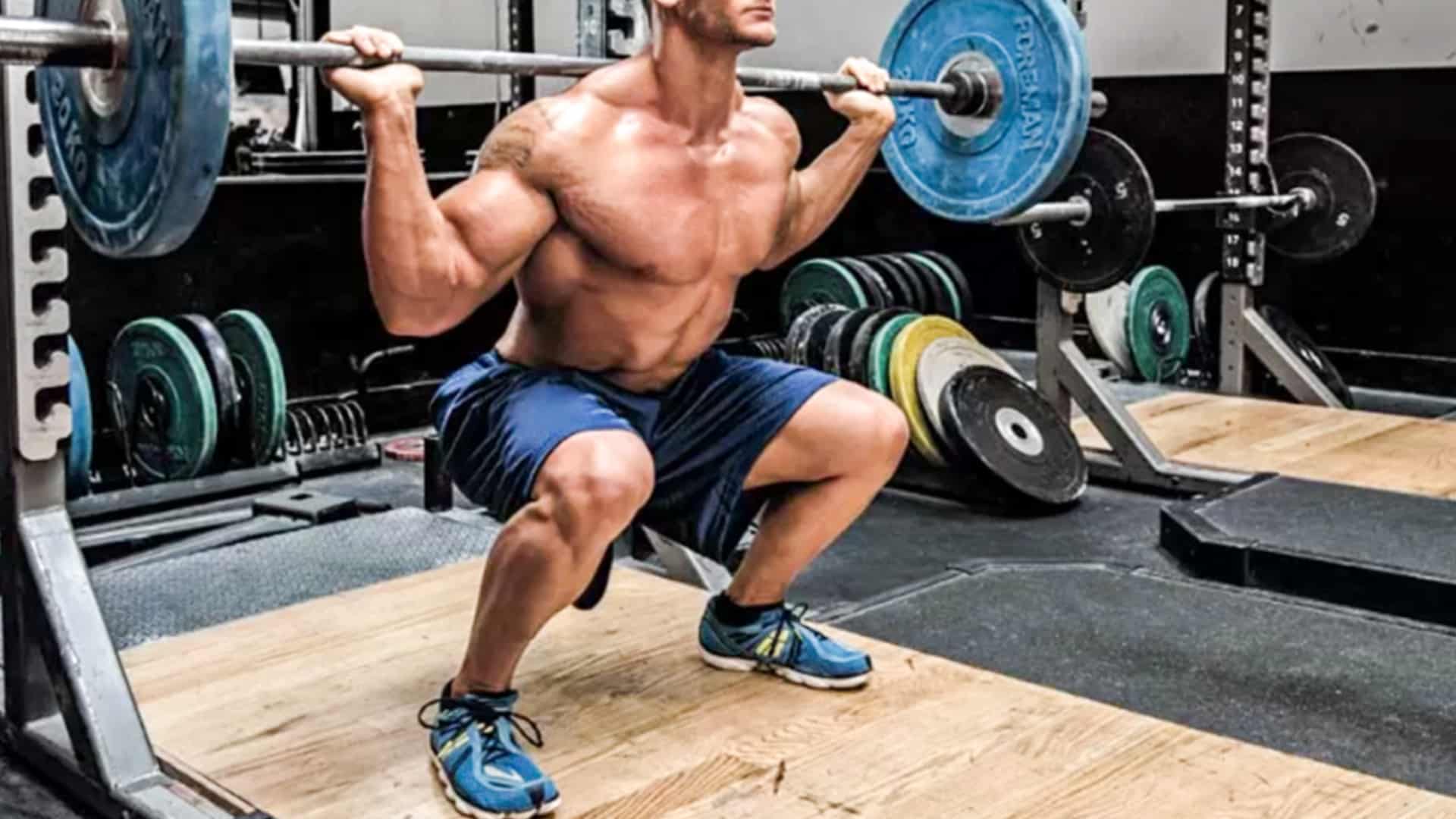
- 15 Mass Building Leg Exercises
- 1. Barbell Squat
- 2. Leg Press
- 3. Leg Extension
- 4. Leg Curl
- 5. Barbell Lunges
- 6. Dumbbell Lunges
- 7. Dumbbell Squat
- 8. Front Squat
- 9. Hack Squat
- 10. Stiff-Leg Deadlift
- 11. Standing Leg Curl
- 12. Smith Machine Squat
- 13. Standing Machine Calf Raise
- 14. Donkey Calf Raises
- 15. Leg Press Machine Calf Raise
- Bonus: Dumbbell Farmers Walk
- How To Build Leg Muscle Mass
- 1. Select the Best Exercise
- 2. Focus On Volume
- 3. Frequency
- 4. Progression
- 5. Recovery
- 6. Training Volume (Sets And Reps)
- Leg Workout Plans for Building Muscle
- For Beginner
- For Intermediate
- Weekly Leg Workout Plans
- 4-Week Beginner Leg Workout Plan
- 8-Week Intermediate Leg Workout Plan:
- 12-Week Advanced Leg Workout Plan:
- Leg Muscle Anatomy
- Quadriceps Muscles
- Hamstring Muscles
- Gluteal Muscles
- Calf Muscle
- Other Lower Leg Muscles:
- FAQs
- How many leg exercises should i do
- What are some common mistakes people make when doing leg exercises?
- How long does it take to see results from leg exercises?
- Can I do leg exercises at home without equipment?
- How often should I do leg exercises?
- Can leg exercises help me lose weight?
- Takeaways
15 Mass Building Leg Exercises
The leg exercises are mostly divided into squat exercises, leg presses, leg extensions, Stiff-Leg Deadlifts, machine squat exercises, lunges, and calf raise exercises.
The 15 best leg exercises to build lower body mass and strength are listed below.
1. Barbell Squat
If there is only one exercise you want to do for leg exercises, then it should be squats. Nothing comes close to squat exercises to build muscle mass and tone the leg muscles.
The barbell squat is the king of all exercises, the only challenger being the barbell deadlift.
Men love this exercise because it strengthens the legs and core. It also helps the body release testosterone and helps to build body-wide muscle and strength.
Women love squats because it is very effective at toning butts and thighs.
You can do squats with a squats machine or with your body weight.
- The basic stance is feet-shoulder-width-apart.
- A wider stance works on the inside of the thigh to a greater degree
- A narrower stance works on the outside of the thigh to a greater degree.
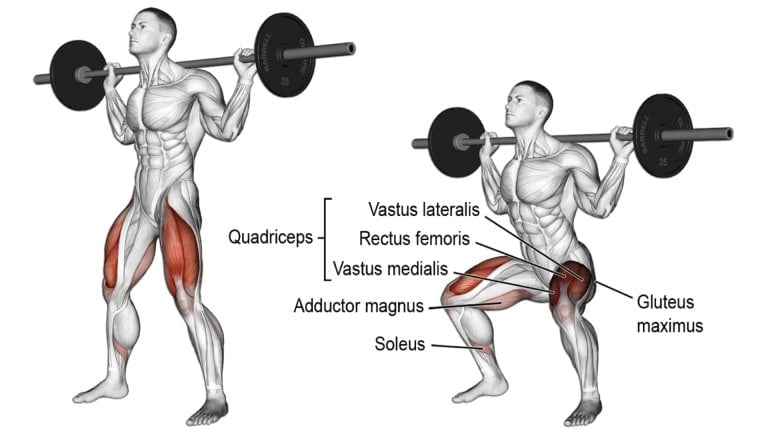
Muscles Worked
Primary: Quadriceps, gluteals.
Secondary: Hamstrings, adductors, spinal erectors, abs
How To Do It
- Step on the rack so that the barbell rests across the back of your shoulders.
- Raise the barbell and get away from the rack if you are doing with free weights.
- Bend your knees, lower your back straight, and head up until your thighs parallel the ground.
- Now raise yourself up using only the thigh power, keeping your back straight in a position with legs nearly locked out.
Tips
- Keep your back straight, torso upright, head up, and feet flat.
- Start light and add weight gradually, allowing your legs and lower back to adapt.
- Concentrate on the form.
- If lifting heavy, have a spotter ready, or use a squat rack or power rack.
Read More To Know More: 20 Best Quad Exercises To Build Mass & Strength
2. Leg Press
If you have back problems or are concerned about lower back pressure, then leg presses are the best thigh-building and toning exercises.
In comparison with the barbell squat, the seated leg press exercises reduce the axial load on your spine and reduce the risk of backache.
Placing your feet low on the footplate emphasizes the quadriceps. Positioning your feet higher on the footplate switches the focus to the glute and hamstrings.
There are 2 types of Leg Presses.
- The Diagonal or Vertical Sled type Leg Press is seen in a few gyms where weights are attached directly to the sled mounted on rails, and you sit below the sled pushing the weights with your feet upwards.
- The Seated Leg Press, where you sit upright and push your feet forward.
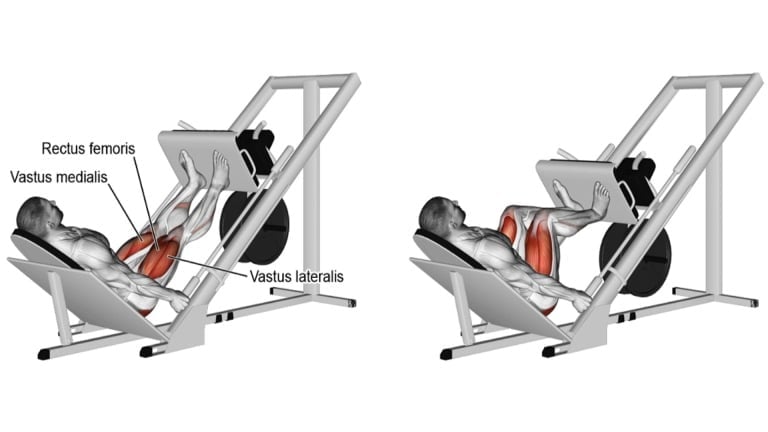
Muscles Worked
Primary: Quadriceps.
Secondary: Gluteals, hamstrings, adductors.
How To Do It
- Sit in the leg press machine and place your feet shoulder-width apart on the footplate.
- Now, bend your knees and allow the weight to lower itself until your knees are near 90 degrees.
- Now, extend your legs and push the weight back to the beginning position by straightening your legs.
Tips
- Move only your legs, and don’t use your arms to push your knees.
- Concentrate on the form
3. Leg Extension
The seated leg extension is an isolation exercise that is performed on a leg extension machine to build and shape your quad muscles.
The leg extension exercises should only be used to warm up your quads, pre-exhaust them before squats, or flush them at the end of a leg workout.
- Pointing your toes directly upward hits all sections of the quadriceps equally.
- Pointing your toes inward, internally rotates the tibia to target the inner quad.
- Placing your toes outward, externally rotates the tibia to hit the outer quad.
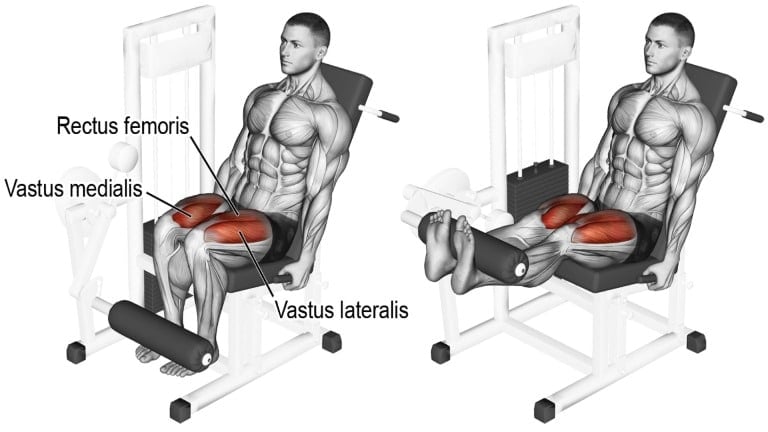
Muscles Worked
Primary: Quadriceps
Secondary: Hamstrings, gluteals. adductors, spinal erectors, abs
How To Do It
- Sit on a Leg extension machine with your legs under the pad and with your back pressed firmly against the back pad.
- Grasp the handles or the seat edges behind your hips and keep your upper body stable.
- Extend your legs as far as possible in a smooth movement until fully extended to get a maximum thigh contraction.
- Contract your quads at the top.
- Slowly lower the weight under control to the starting position.
Tips
- Do not go too heavy because it can be bad for your knees.
- Do not lock your knees at full extension. This can strain the knee joint.
4. Leg Curl
Leg curl, or hamstring curl, is the best way to build muscle mass in the hamstrings (back of thigh muscles). It also works the calf and glutes muscles.
- Pointing your toes straight targets all three hamstring muscles.
- Pointing the toes inward emphasizes the inner hamstrings (semimembranosus and semitendinosus),
- Pointing the toes outward focuses effort on the outer hamstrings (biceps femoris).
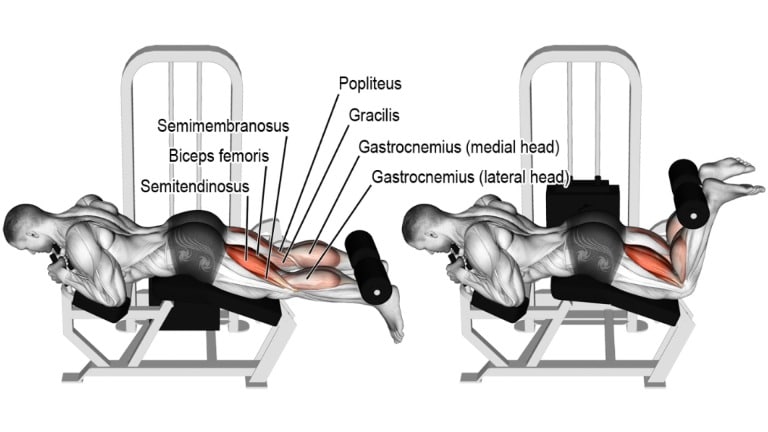
Muscles Worked
Primary: Hamstrings.
Secondary: Gluteals, calf muscles.
How To Do It
- Lie faced down on a lying leg curl machine and extend your legs straight.
- Position your legs under the support pads.
- Curl the weight by bending your knees and raising your heels toward your buttocks.
- Hold the handles or bench to prevent yourself from lifting off the bench. Keep the movement smooth.
- Lower the weight to the starting position.
Tips
- Keep your spine straight, and do not raise your chest upward.
- Go full range. Avoid jerky movements.
- Bend your knees as far as possible during the upward phase. Stop a few degrees short of full extension at the bottom to keep tension on the hamstrings and minimize stress across the knee joint.
Read More To Know More: 15 Best Hamstring Exercises For Mass And Strength
5. Barbell Lunges
The barbell lunge is a brilliant exercise to develop balance, coordination, and your legs’ unilateral (one-sided) functional strength.
Barbell Lunges are a power move to build thigh and butt muscles. Learn the correct technique and blast your thighs now.
Also, try walking lunge: Instead of returning to the same start position, do a lunge walk. Perform lunges, one leg after another, so that you walk the length of the gym floor.
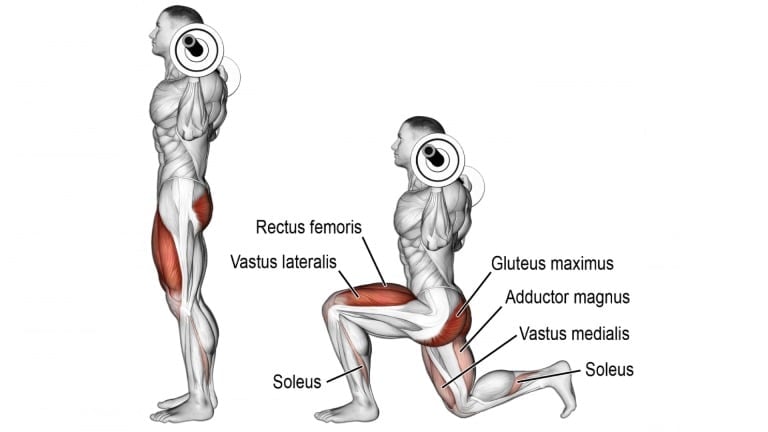
Muscles Worked
Primary: Quadriceps.
Secondary: Gluteals, hamstrings, adductors.
How To Do It
- Holding a barbell behind the neck, stand upright.
- Take a step forward by bending your knees and getting them close to the floor. Keep your back straight.
- Push yourself back to the starting position and repeat with the other foot.
Tips
- Bend as far and low as possible without losing form.
- Keep your torso upright and your head facing forward.
- If you suffer from balance problems, it is best either avoid it, or use your own body weight while holding on to a steady object.
6. Dumbbell Lunges
Along with squats, dumbbell lunges are highly recommended to build your butt muscles and glutes.
Dumbbell lunges require good balance, so if you have balance issues, start by doing the lunges exercise without weights.
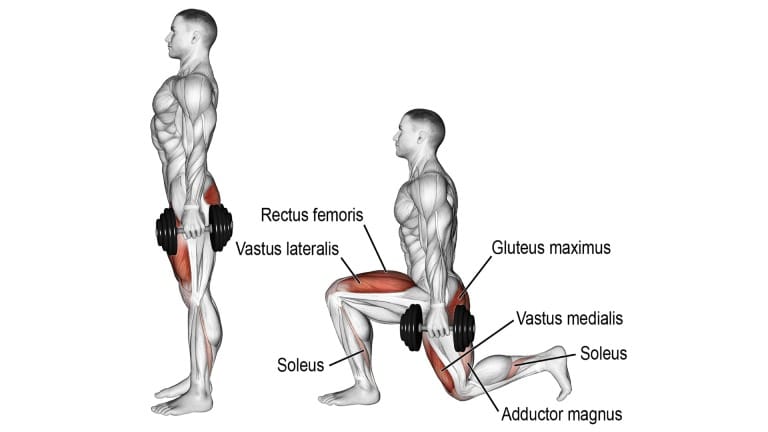
Muscles Worked
Primary: Quadriceps.
Secondary: Gluteals, hamstrings, adductors.
How To Do It
- Hold a dumbbell in each hand, with your arms by your sides, and stand upright.
- Keep your back straight and walk forward. Bend your knees and bring them close to the ground.
- Push yourself back to the starting position and repeat with the other foot.
- Keep alternating the leg with which you lunge.
Tips
- Bend as far and low as possible without losing form.
- Keep your torso upright and your head facing forward.
- Be careful that the knee of the forward leg does not extend past the toes as you bend the leg.
7. Dumbbell Squat
The dumbbell squat is a popular exercise that targets the leg muscles, particularly the quadriceps, hamstrings, and glutes.
It is a compound exercise, meaning it works multiple muscle groups at once, and can be performed by people of all fitness levels.
One benefit of the dumbbell squat over the barbell squat is that you can perform it anywhere without needing a spotter.
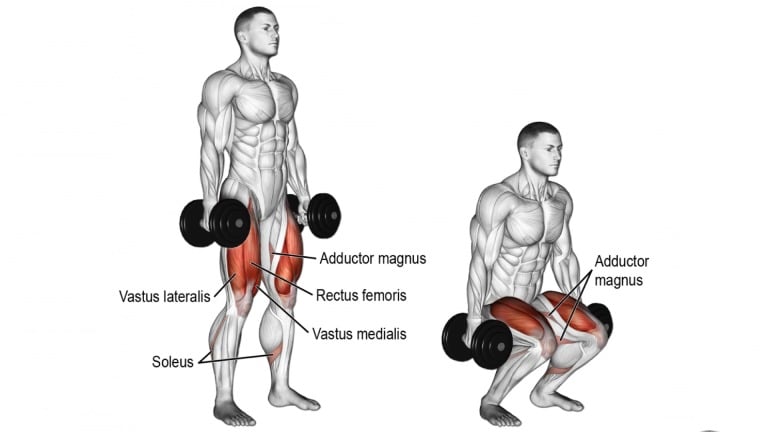
Muscles Worked
Primary: Quadriceps, gluteals.
Secondary: Hamstrings, adductors, spinal erectors, abdominals.
How To Do It
- Stand with your feet shoulder-width apart, holding a dumbbell in each hand at your sides.
- Keep your chest up and engage your core as you lower yourself down into a squat position.
- Ensure your knees stay in line with your toes and do not extend past them.
- Lower yourself until your thighs are parallel to the ground or as close as you can comfortably go.
- Push through your heels and stand up again. Straighten your legs and come back to where you started.
Tips
- Keep your torso upright, shoulders back, head up, and feet flat.
- Start with a manageable weight and increase it as you become stronger.
- Before heavy squats, it is important to warm up well.
8. Front Squat
The front squat is a more advanced version of the barbell squat that works the muscles of the legs. The front squat will place a great deal of emphasis on the quads.
The barbell and front squat work the same target and synergistic muscles.
However, the barbell front squat recruits more stabilizer muscles, including various back muscles, your shoulders, and your chest.

Muscles Worked
Primary: Quadriceps, gluteals.
Secondary: Hamstrings, adductors, spinal erectors, abdominals.
How To Do It
- Step onto a squat rack and grasp the bar with your crossed arms. Lift it off the rack.
- Step back from the rack with your feet slightly wider than hip-width apart.
- Maintain the natural arch in your lower back and keep your head directed forward.
- Descend until your thighs are at least parallel to the ground.
- From this position, push yourself back to the starting point. Repeat.
Tips
- Keep your back straight, torso upright, head facing forward, and feet flat.
- Start light and add weight gradually, allowing your legs and lower back time to adapt.
- If lifting heavy, have a spotter ready, or use a squat rack or power rack.
9. Hack Squat
The machine hack squat is a variation of the squat and an exercise used to build the muscles of the legs.
In particular, the hack squat will target the glutes & hip flexors, and quadriceps and also involves the calves and hamstrings.
The hack squat machine helps you keep your core stable, so your muscles do not have to work as hard as they would with the barbell squat.
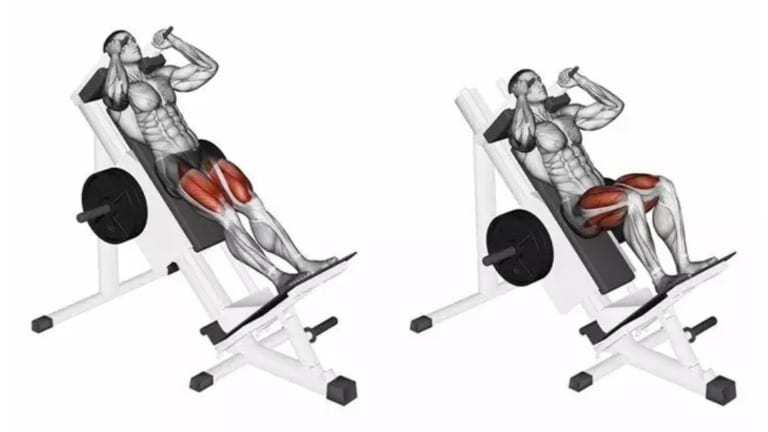
Muscles Worked
Primary: Quadriceps, gluteals.
Secondary: Hamstrings, adductors, spinal erectors, core
How To Do It
- Get on a hack squat machine, place your back flat against the back pad, and get your shoulders under the support.
- Grasp the side handles of the machine and place your legs in a shoulder-width stance with your toes pointed out slightly.
- Straighten your legs, but do not lock your knees.
- Inhale as you slowly lower the weight by bending your knees.
- Go down as low as possible, thighs parallel to the floor. Hold for a count of one.
- Return to the start position by pushing down through your heels and extending your legs, exhaling as you do so.
Tips
- Your back should remain on the pad while you are performing this exercise.
- Keep your feet and knees pointing in the same direction for the safety of your ankles and knees.
10. Stiff-Leg Deadlift
The stiff leg deadlift is a variation of the deadlift and an exercise used primarily to target the muscles of the hamstrings, glute, and erector spinae.
The stiff-leg deadlift for hamstrings requires a lighter weight than the traditional deadlift lift to strengthen the lower back.
A grip with one palm facing forward and the other facing back keeps the bar from rolling.
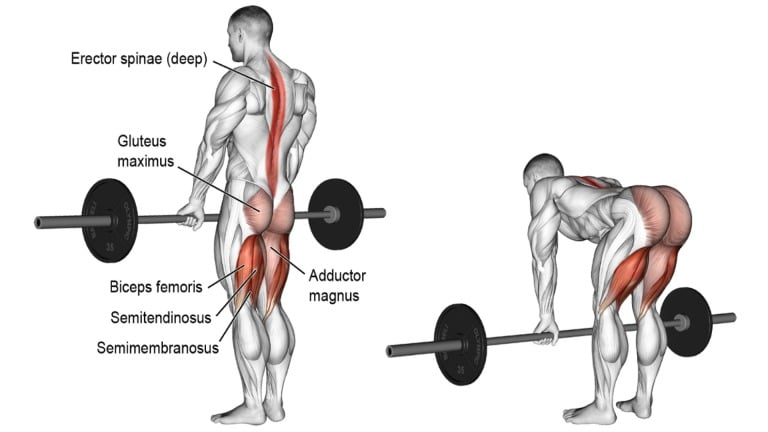
Muscles Worked
Primary: Hamstring, gluteals.
Secondary: Spinal erectors, quadriceps.
How To Do It
- Grasp a barbell using a shoulder-width pronated (overhand) or mixed grip.
- Keeping your back straight, head up, and hips low, lift the barbell into a standing position.
- Flex your knees a little, push your hips backward, and slowly lower the barbell down the front of your legs.
- Descend until you feel a mild stretch in your hamstrings.
- Exhale as you lift the barbell back to where you started.
Tips
- Keep your knees stiff, your back and arms straight, and your head up.
- Do not allow the bar to drift away from your body during the lift. Keep the barbell close to your body.
- Keep soft knees and ensure the movement occurs primarily at your hips.
- Lower the weight until your hamstrings reach full stretch without rounding your spine.
11. Standing Leg Curl
The Standing Leg Curl is a resistance exercise used to strengthen the hamstrings, buttocks, and calves.
You pull your heels toward your buttocks from your position on the machine to do a leg curl.
In contrast to the lying leg curl, the standing leg curl is performed with one leg at a time, which helps muscle isolation and focus.
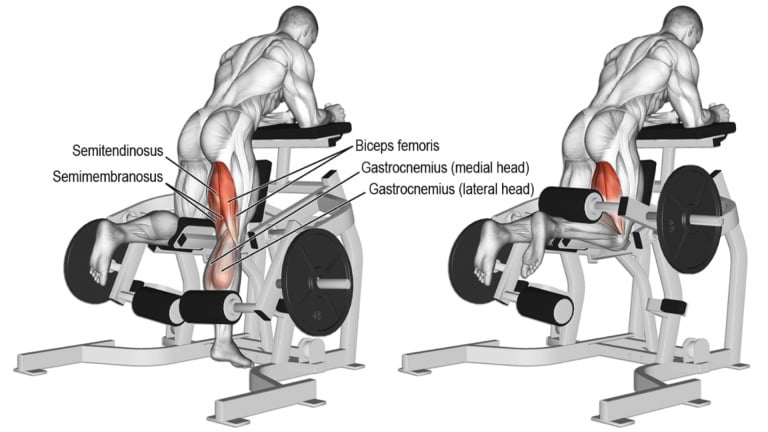
Muscles Worked
Primary: Hamstrings.
Secondary: Gluteals, calf muscles.
How To Do It
- Standing facing the machine, slightly to one side of it.
- Hook one heel under the roller pad and support your weight with the other leg.
- Lift the weight by bending your knee and raising your heel toward your buttocks.
- Hold for a couple of counts and slowly lower the weight back down to the start position.
- Finish the set, then switch legs and repeat.
Tips
- Stretch your hamstrings before and after this exercise to reduce the risk of injury.
- Keep your back straight and perform with controlled motion.
- Don’t force your body to compensate by lifting the hips and flexing your lower back.
- To properly execute a leg curl, always start with a lighter weight.
12. Smith Machine Squat
Squats on a Smith machine help stabilize your core and correct your posture while doing a squat.
An advantage of the Smith machine squat is being able to place your foot stance further forward than usual and target more of the glutes and hamstrings rather than the exercises being quadriceps-dominant
The Smith machine squat allows you to squat a heavyweight safely without a spotter. Just make sure that you use the safety pins.
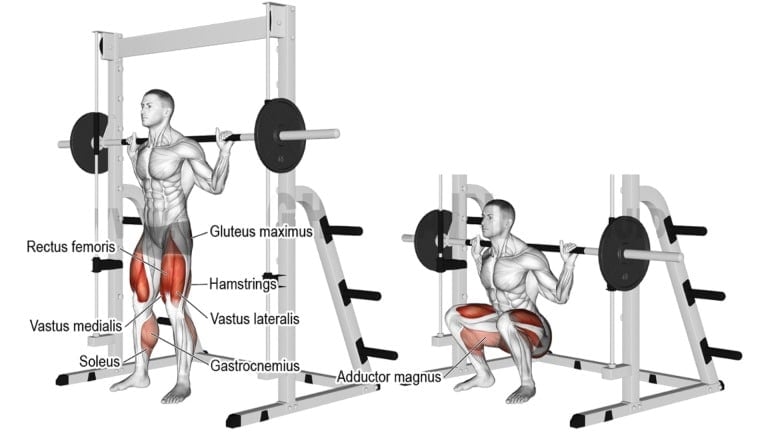
How To Do It
- Stand on a machine and place the barbell behind your shoulders and slightly below your neck.
- Hold on to it with your hands just outside your shoulders. Twist the bar to unrack it.
- Grasp the barbell with palms facing forward and hands wider than shoulder width apart.
- With your chest high, head forward, and back slightly arched, bend your knees and hips.
- Inhale as you slowly lower the barbell by getting into a squat position.
- Exhale and push off with your legs to return to the starting position.
Tips
- Keep your back straight, torso upright, head up, and feet flat.
- Start light and add weight gradually, allowing your legs and lower back to adapt.
- Concentrate on form.
Read More To Know More: 12 Most Effective Smith Machine Leg Workout & Exercises
13. Standing Machine Calf Raise
The standing machine calf raise is an excellent exercise for isolating the calves.
Standing calf raises work the two muscles that run down the back of your lower leg: the gastrocnemius and soleus.
Aim for a full stretch at the bottom and a full squeeze at the top to maximize the range of motion.
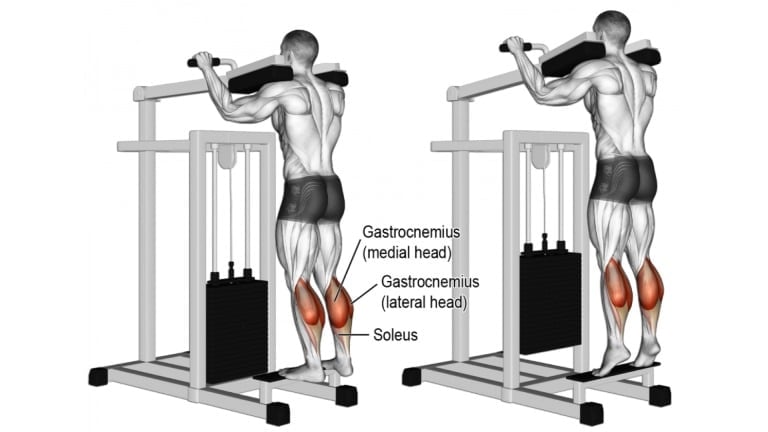
Muscles Worked
Primary: Gastrocnemius.
Secondary: Soleus.
How To Do It
- Step on a calf raise machine with your toes on a block and heals extended into space.
- Place the shoulders under the pads and hook the weight of the support.
- Now raise yourself up using only the toes and come as far as possible.
- Hold this position for a second, flexing your calf muscles.
- Slowly lower your heels as far as possible towards the floor. Keep your knees slightly bent.
- Go as heavy as possible. With time, you can perform partial repetitions once you tire on a set.
Tips
- The movement too quickly isn’t effective—it’s best to raise and lower your heels slowly.
- Keep your chest up and stand tall to stay properly balanced while performing calf raises.
- To help keep your balance, keep your eyes facing forward at all times.
14. Donkey Calf Raises
Donkey calf raises are an excellent bodyweight calf raise exercise for building calf muscles. This raise is mostly the second option after standing calf raises.
The donkey calf raises primarily engages the two muscles that comprise the calves: the gastrocnemius and the soleus.
It secondarily activates the hamstrings and abs. When you bend over to initiate the calf raise, the hamstrings receive a stretch.
Add this exercise as a variation to your calf workouts, adding some variety to your leg workouts.
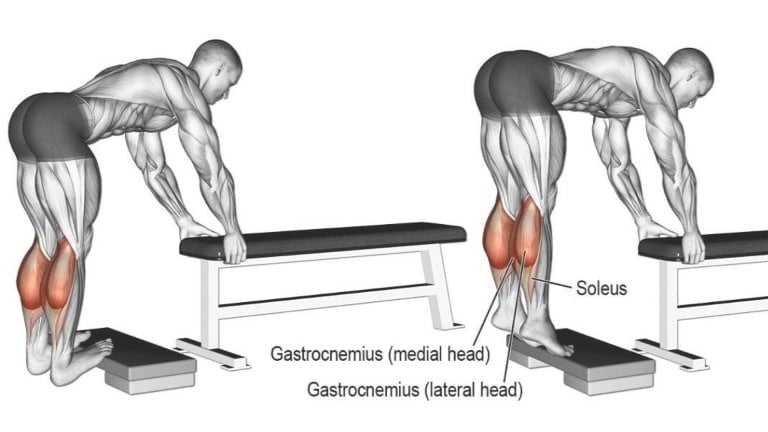
Muscles Worked
Primary: Hamstrings.
Secondary: Gluteals, calf muscles.
How To Do It
- Stand on a board and bend forward, holding a table for support.
- Lower your heels, get as low as possible, and fully contract your calf muscles.
- Extend your calves and get back to the starting position.
- Repeat for the desired number of reps.
Tips
- Exhale while you exert, in this case, while raising your calves against resistance.
- Go full range of motion. Go through full-range movements to target the calves muscles, including both gastrocnemius and soleus muscles.
- Use high blocks to ensure you are not limited in the range of your movements.
Know More: Bodyweight Calf Raise To Build Mass And Strength Of Calves
15. Leg Press Machine Calf Raise
The leg press calf raise is a variation of the machine calf raise and an exercise used to build the muscles of the calves.
The calves can be a very stubborn muscle group, so targeting them with plenty of different angles and a high training frequency is important.
Working your calves on the machine has a great benefit compared to standing calf raises. That is, it does not put stress on your spine.
It supports your upper and lower back. Hence, if you have problems with your spine or your back, use the seated leg press machine instead of the vertical moves.
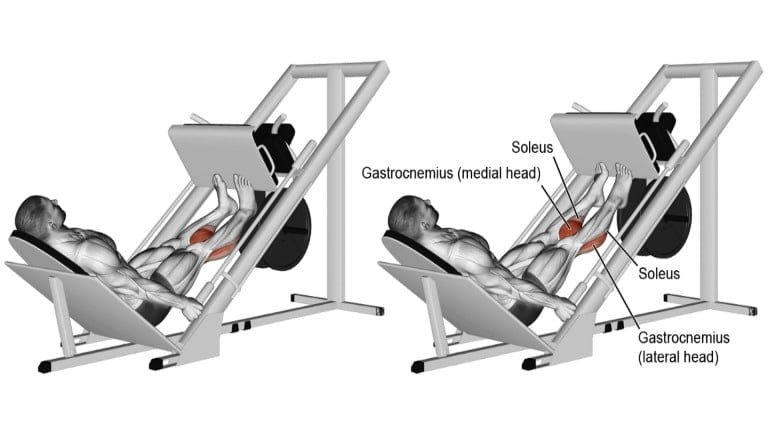
Muscles Worked
Primary: Hamstring, gluteals.
Secondary: Spinal erectors, quadriceps.
How To Do It
- Put your feet on the bottom of a leg press machine and let your heels hang off the footplate.
- Press the footplate up from the safety hooks (but do not unlatch them) by straightening your legs.
- Drop your toes down toward your shins to stretch your calves.
- Press the weight up with your toes by contracting your calf muscles.
- Hold this position for a second, flexing your calf muscles, then lower your heels back to the starting position.
Tips
- Keep the repetitions slow and controlled. Limit momentum and pause at the top to emphasize the contraction.
- Try to move through the ball of the foot rather than the base of the toes.
- To perform the exercise correctly and safely, you must wear proper footwear. No slippers.
Bonus: Dumbbell Farmers Walk
The dumbbell farmer’s walk is a great exercise for improving your grip strength and building your forearms. It also improves your overall strength and functional fitness by strengthening your core, back, glutes, legs, and gait.
The farmer’s walk exercise also called the farmer’s carry, is a strength and conditioning exercise in which you hold a heavy load in each hand while walking for a designated distance.
Farmer’s Walk with Dumbbells might be one of the classic exercises and a move that man’s been doing since the beginning of time.
The Farmer’s Walk allows you to accomplish much in one exercise.
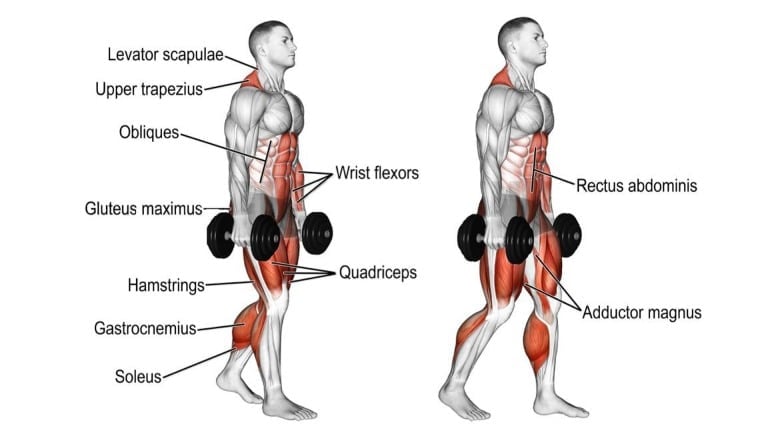
Muscles Worked
Primary: Trapezius, Levator Scapulae, Rhomboids, Erector Spinae, Abs.
Secondary: Gluteus Maximus, Hamstrings, Quadriceps.
How To Do It
- Deadlift a pair of dumbbells from the floor. Reach down, bending at the hips and knees, and grasp the dumbbells in each hand.
- Hold the dumbbells at your side with a firm grip. Stand tall, keeping your shoulders, back, and core tight.
- Take small steps and walk forward at an even pace with your eyes focused straight ahead of you.
- Complete the desired number of steps, come to a stop, and place the dumbbells down while keeping a tight core and neutral spine.
Tips
- Focus on squeezing your shoulder blades and tightening your abs.
- Keep a neutral or straight spine throughout the movement to avoid injury.
How To Build Leg Muscle Mass
Structuring a leg workout program involves several key factors to consider, including exercise selection, volume, frequency, and progression.
Here are some tips for structuring an effective leg workout program:
1. Select the Best Exercise
Choose exercises that work different parts of the leg muscles, like the quad, hamstring, glutes, and calf muscles, and do them in different ways.
2. Focus On Volume
The volume of your workout program refers to the number of sets, reps, and exercises performed in each workout.
A good starting point is to perform 3–4 sets of each exercise for 8–12 reps. Increase the volume gradually over time to promote muscle growth and adaptation.
3. Frequency
How often you perform leg workouts depends on your fitness level and goals.
- For beginners, 1-2 leg workouts per week are recommended,
- While advanced lifters may benefit from 2-3 leg workouts per week.
4. Progression
Progression refers to gradually increasing the weight, reps, or sets over time to promote muscle growth and adaptation.
This can be achieved by increasing the weight lifted, increasing the number of reps performed, or decreasing rest time between sets.
5. Recovery
Adequate rest and recovery are important for muscle growth and injury prevention. Make sure to allow for at least one day of rest between leg workouts, and prioritize sleep, nutrition, and hydration to support recovery.
6. Training Volume (Sets And Reps)
For building muscle mass, how much total training volume per week is more important than how often you train
Of course, the number of sets and reps will be determined based on your fitness journey, but here is a great starting point:
Sets
- Beginners (with a year or less of training) should aim for about 12 weekly sets.
- An Intermediate trainee (with two to four years of training) can increase the volume to 16 sets per week.
- An advanced trainee (four or more years of training) may be able to get in up to 20 weekly sets.
Reps
The best rep ranges and loads to work with.
- For muscle endurance: 15-20+ with a light load
- For muscle strength: 6–8 reps with a heavy load
- For muscle hypertrophy (increased muscle size): 8–15 reps with moderate load
The load should bring you to or near failure within the given rep ranges for the exercise to be effective.
You’ll need to use a range of gym equipment (dumbbell, cable, bodyweight) and techniques if you want to train the muscle group effectively.
Leg Workout Plans for Building Muscle
For Beginner
| Exercise | Sets x Reps | Rest |
| Bodyweight squats | 3 x 8 | 60-90 seconds |
| Dumbbell Lunges | 3 x 10 | 60-90 seconds |
| Glute bridge | 3 x 10 | 60-90 seconds |
| Calf raises | 3 x 8 | 60-90 seconds |
For Intermediate
| Exercise | Sets x Reps | Rest |
| Barbell squats | 3 x 8 | 45-60 seconds |
| Deadlifts | 3 x 10 | 45-60 seconds |
| Cable pull through | 3 x 10 | 45-60 seconds |
| Standing calf raises | 3 x 8 | 45-60 seconds |
| Leg press | 3 x 8 | 45-60 seconds |
Weekly Leg Workout Plans
The frequency of the leg workout plan can vary depending on your goals, fitness level, and training schedule.
- If you are training your leg one day a week, then you should do all the exercises shown in the plan.
- If you are training your leg two times a week, then split the exercises shown into a weekly schedule.
4-Week Beginner Leg Workout Plan
Week 1-2:
- Squats – 3 sets of 10 reps
- Lunges – 3 sets of 10 reps (each leg)
- Leg Press – 3 sets of 10 reps
- Calf Raises – 3 sets of 12 reps
Week 3-4:
- Deadlifts – 4 sets of 12 reps
- Leg Extensions – 4 sets of 12 reps
- Leg Curls – 4 sets of 12 reps
- Calf Raises – 4 sets of 15 reps
8-Week Intermediate Leg Workout Plan:
Week 1-4:
- Back Squats – 4 sets of 8 reps
- Romanian Deadlifts – 4 sets of 8 reps
- Leg Press – 3 sets of 10 reps
- Standing Calf Raises – 3 sets of 12 reps
Week 5-8:
- Front Squats – 4 sets of 8 reps
- Stiff-Leg Deadlifts – 4 sets of 8 reps
- Lunges – 3 sets of 10 reps (each leg)
- Barbell Hip Thrust – 4 sets of 8 reps
- Seated Calf Raises – 3 sets of 12 reps
12-Week Advanced Leg Workout Plan:
Week 1-4:
- Barbell Back Squats – 5 sets of 5 reps (heavier weight)
- Romanian Deadlifts – 4 sets of 8 reps (slightly lighter weight)
- Leg Press – 3 sets of 10 reps (moderate weight)
- Cable Hip Adduction-4 sets of 8 reps (light weight)
- Standing Calf Raises – 3 sets of 15 reps (moderate weight)
Week 5-8:
- Barbell Front Squats – 4 sets of 6 reps (moderate-heavy weight)
- Barbell Bulgarian Split Squats – 3 sets of 10 reps (each leg) (heavier weight)
- Romanian Deadlifts – 4 sets of 8 reps (moderate-heavy weight)
- Cable Pull through – 4 sets of 8 reps (light-moderate weight)
- Seated Calf Raises – 3 sets of 15 reps (moderate-heavy weight)
Week 9-12:
- Barbell Sumo Deadlifts – 5 sets of 5 reps (heavier weight)
- Barbell Lunges – 3 sets of 10 reps (each leg) (moderate-heavy weight)
- Leg Extensions – 3 sets of 12 reps (moderate weight)
- Dumbbell Step Up – 3 sets of 12 reps (moderate weight)
- Donkey Calf Raises – 3 sets of 15 reps (moderate-heavy weight)
These are sample exercise plans that you can modify to meet your needs and goals.
Leg Muscle Anatomy
The legs consist of dozens of muscles that flex, bend, extend, adduct, abduct, and rotate your legs and allow movement.
The leg is divided into the upper leg (thigh) and lower leg (calf).
The upper leg consists of one bone, the femur, whereas the lower leg consists of two bones, the tibia (located on the big-toe side) and fibula (on the little toe side).
This ultimate leg workout focuses on four main muscle groups — the quadriceps, hamstrings, glutes, and calves.
Understanding how they all fit together and work with each other will ensure you get the most out of your workout.
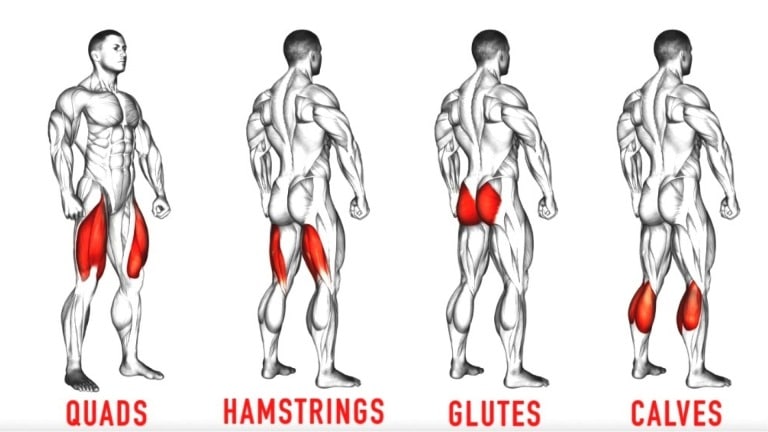
Quadriceps Muscles
The quadriceps femoris, located in front of the thigh, has four separate heads:
- Rectus femoris arises from the front of the pelvic bone.
- Vastus medialis arises from the inner edge of the femur.
- Vastus lateralis arises from the outer edge of the femur.
- Vastus intermedius arises from the front surface of the femur and lies underneath the rectus femoris.
The four heads merge, attach onto the patella (knee cap), and then insert via a single (patellar) tendon onto the tibia, just below the knee joint.
The main function of the quadriceps is to extend the knee and straighten the leg.
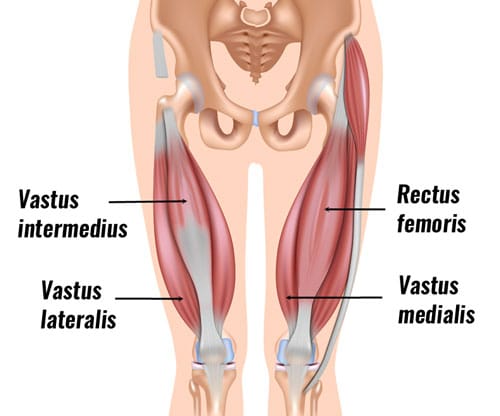
Hamstring Muscles
The hamstrings, located behind the thigh, are a group of three muscles originating from the pelvis’s ischium bone.
- Biceps femoris passes behind the outer aspect of the thigh to attach to the head of the fibula bone, just below the knee.
- Semimembranosus passes behind the inner aspect of the thigh, attaching to the upper tibia bone behind the knee.
- Semitendinosus passes behind the Inner aspect of the thigh, attaching to the upper tibia bone adjacent to semimembranosus.

Gluteal Muscles
The gluteus maximus arises from a large area on the rear of the pelvic bone, passes down behind the hip joint, and attaches to the upper femur. This powerful muscle causes hip extension.
Other thigh muscles Include the following:
- Hip adductors (Inner thigh): Gracilis; adductor longus, magnus, and brevis
- Hip abductors: Tensor fascia latae; gluteus medius and mlnimus
- Hip flexors: Sartorius, Iliopsoas, rectus femoris
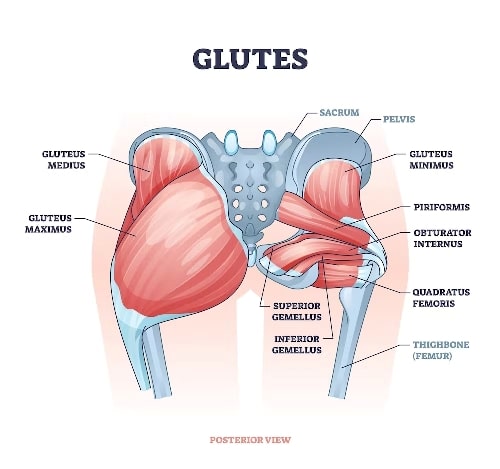
Calf Muscle
The calf comprises two muscles:
- The gastrocnemius is the visible muscle of the calf. The two heads (medial and lateral) of the gastrocnemius arise from the rear of the femur bone. immediately above the knee joint.
- The soleus arises from the rear aspect of the tibia and lies underneath the gastrocnemius.
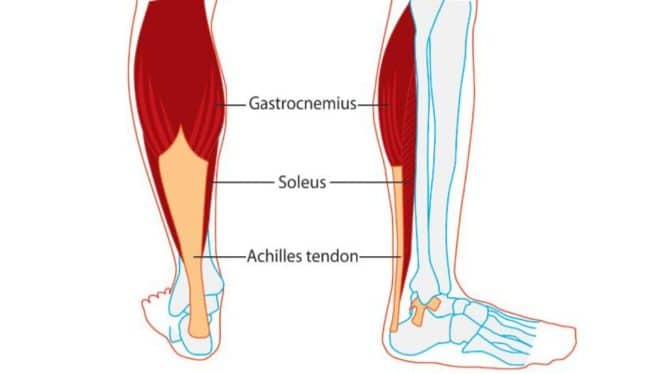
Other Lower Leg Muscles:
- libialis anterior, Ankle eversion: Peroneus longus and brevis, libialis posterior
- Flexor dlgitorum longus, flexor hallucis longus, extensor digitorum longus, and extensor halluds longus.
FAQs
How many leg exercises should i do
A workout routine with 2-4 different leg exercises per session is generally sufficient for most people. It’s important to focus on quality over quantity and to give your muscles time to recover between workouts.
Talk to a trainer if you’re unsure what workout routine is best for your goals.
What are some common mistakes people make when doing leg exercises?
Some common mistakes people make when doing leg exercises include:
- Using improper form or technique,
- using too much weight or resistance,
- neglecting to warm up or stretch and
- Failing to rest and recover between workouts properly.
How long does it take to see results from leg exercises?
Leg exercises can include your fitness level, workouts’ frequency and intensity, and diet and lifestyle habits.
Some strength, endurance, and muscle tone improvements can be noticed after a few weeks of consistent training. Still, it can take several months to see significant changes in muscle mass and overall fitness.
Can I do leg exercises at home without equipment?
Yes, there are many leg exercises that can be done at home without equipment, like squats, lunges, calf raises, and step-ups.
Bodyweight leg exercises are just as effective as using weights or machines.
How often should I do leg exercises?
You should do leg exercises at least 1–2 times a week. If you want to build strength and muscle mass, you can increase the frequency or intensity of your leg workouts.
Can leg exercises help me lose weight?
Yes, leg exercises can help you lose weight by increasing your overall calorie burn and helping you build muscle. The more muscle you have, the more calories you burn at rest.
Furthermore, leg exercises can help to tone and shape your legs for a more aesthetically pleasing look.
Takeaways
An effective leg workout program involves a combination of exercise selection, volume, frequency, and progression, as well as proper nutrition and recovery strategies.
You can achieve your fitness goals by Using various exercises to work out your leg muscles, gradually increasing the volume and intensity of your workouts, and taking time to rest and recover.
With consistency and dedication, you can master the leg workout and build a strong, defined, and impressive lower body.

Manish is a NASM-certified fitness and nutrition coach with over 10 years of experience in weight lifting and fat loss fitness coaching. He specializes in gym-based training and has a lot of knowledge about exercise, lifting technique, biomechanics, and more.
Through “Fit Life Regime,” he generously shares the insights he’s gained over a decade in the field. His goal is to equip others with the knowledge to start their own fitness journey.
